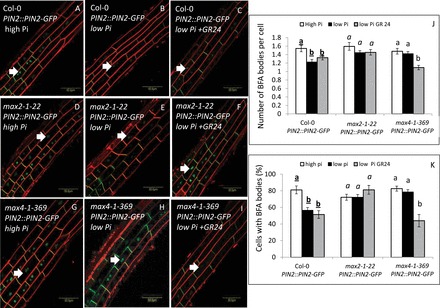Fig. 2.

Quantification of PIN2-containing BFA bodies in the epidermal cells of the primary-root elongation zone in PIN2::PIN2–GFP seedlings grown under high (2mM) and low (1 µM) Pi conditions (48h HPG) and the effect of GR24 treatment. (A–I) PIN2-containing BFA bodies (green, PIN–GFP signal; red, FM4-64) in Col-0 (A–C), max2-1–22 (D–F), and max4-1–369 (G–I) roots grown on high-Pi plates (A, D, G), low-Pi plates (B, E, H), and low-Pi plates supplemented with GR24 (C, F, I) and treated with BFA (100 µM, 1h). Arrows indicate PIN2-containing BFA bodies. Bars, 50 µm. (J) Number of PIN2-containing BFA bodies per cell in the apical plasma membrane of Col-0, max2-1–22 and max4-1–369 roots grown on high-Pi plates (white columns), low-Pi plates (black columns), and low-Pi plates supplemented with GR24 (grey columns) and treated with BFA (100 µM, 1h). (K) Percentage of cells with PIN2-containing BFA bodies in the apical plasma membrane of Col-0, max2-1–22, and max4-1–369 roots grown on high-Pi plates (white columns), low-Pi plates (black columns), and low-Pi plates supplemented with GR24 (grey columns) and treated with BFA (100 µM, 1h). Cells (n=50–60) from 10 plants were examined for each of three replicates. Different lower-case letters above the bars indicate statistically significant differences between means by a multiple-comparison Tukey–Kramer test (P≤0.05).
